Natural Form Drawing Workshop
Richard
Bell's nature diary,
London, Thursday 9 September
2010
previous
| home
page
| this
month
| e-mail
richard
| next
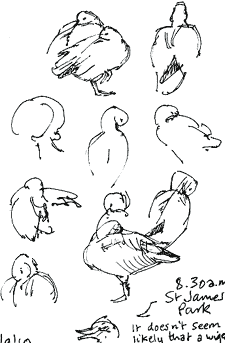 St. James Park, 8.30 am.
St. James Park, 8.30 am.
 IT DOESN'T seem likely that a wigeon is higher in the pecking order than a mallard but the drake strutting along the water's edge is apparently out to impress a couple of females who are walking along with him. He's in a mood to pick a fight with everyone he meets, so the larger mallard is wise to give him a wide berth. I've stopped for a few minutes to draw the sleeping and preening snow geese (right), but they move when a gang of larger bar-headed geese swagger along the lakeside path.
IT DOESN'T seem likely that a wigeon is higher in the pecking order than a mallard but the drake strutting along the water's edge is apparently out to impress a couple of females who are walking along with him. He's in a mood to pick a fight with everyone he meets, so the larger mallard is wise to give him a wide berth. I've stopped for a few minutes to draw the sleeping and preening snow geese (right), but they move when a gang of larger bar-headed geese swagger along the lakeside path.
 On my walk via Trafalgar Square and the Royal Parks, I take a tea-break at the Serpentine Cafe on the terrace overlooking the lake. A heron flies in and sits on the railing by the next table. I'm surprised how small a heron looks when it's sitting so close to you.
On my walk via Trafalgar Square and the Royal Parks, I take a tea-break at the Serpentine Cafe on the terrace overlooking the lake. A heron flies in and sits on the railing by the next table. I'm surprised how small a heron looks when it's sitting so close to you.
Back to College
It's such a fresh, sunny morning when I arrive at the Natural Form Drawing class that I suggest to John Norris Wood, my tutor from college days, that we should adjourn to the zoo but we're in the drawing studio on the seventh-floor of Royal College of Art, overlooking Kensington Gardens. The studio was formerly the college greenhouse where I often drew and painted. The class is for ex-students but only three of us are graduates from John's Natural History Illustration course. The man in the stripy tee shirt (left) is an animator and the man next to him (far left) is a designer. He tells me that when he first arrived at the college, in the late 1960s; he had nowhere to stay so he slept in the park for the first few weeks.

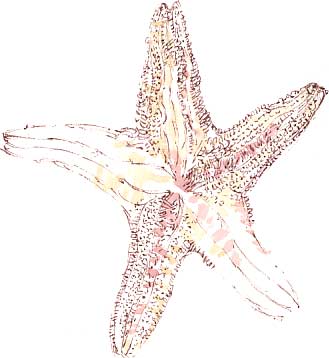 Starfish
Starfish
I don't want to waste any time so, even before the class officially gets underway, I pick up a starfish from the collection of natural form objects available and start drawing it on my sketchbook page next to the crab shell that I drew in the bed and breakfast at Runswick Bay at the weekend.
With natural form you could, if you were determined enough, spend the whole day making a single study of the complex surface pattern of an object like this but I don't feel settled enough to focus with such intensity, perhaps because of all the excitement of dashing around London yesterday afternoon and on the way here this morning.
Because of this, I don't want to overdo the drawing but when it comes to the underside (right), how should I tackle the three parallel rows of white dots along the edges of each arm, like traffic neatly arranged along both carriageways of a motorway? I don't want to spend the entire day drawing several thousand dots individually.
John suggests drawing one of the arms in detail then leaving the other four as lightly drawn suggestions.
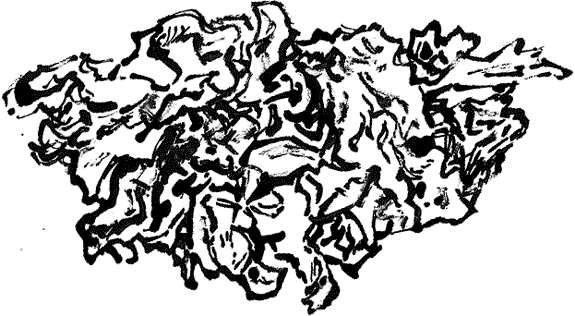
Lichen
But I feel that drawing in my usual pen and wash technique isn't making the best use of my day in the natural form drawing class. I could have stayed on the coast for an extra day if I'm just going carry on as usual. Surely I should be doing something more experimental? From the drawing materials available in the studio, I put a little black acrylic in a jam jar and use a rather battered bristle brush to draw what I believe is a piece of dried lichen (above).
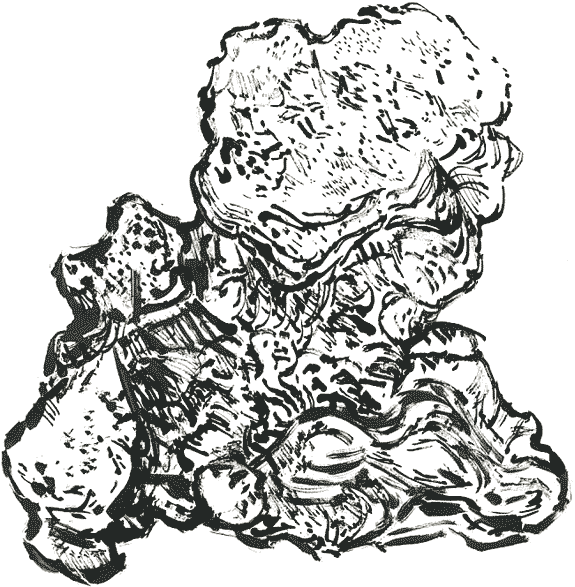
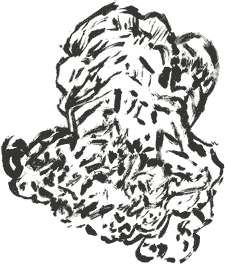 Bracket Fungus
Bracket Fungus
I've no sooner done that than I notice that one of the students (another animator) has found a bamboo pen and some ink and - as is always the case when you're in a drawing class - I'm convinced that her drawing is flowing a lot more successfully than mine. I take a piece of the bamboo that John has brought in and cut a rough nib at one end. That seems to be nearer to what I have in mind. My homemade bamboo pen (above) enables me to get a greater variety of line than I can with the old brush and the acrylic (left, much reduced in size).
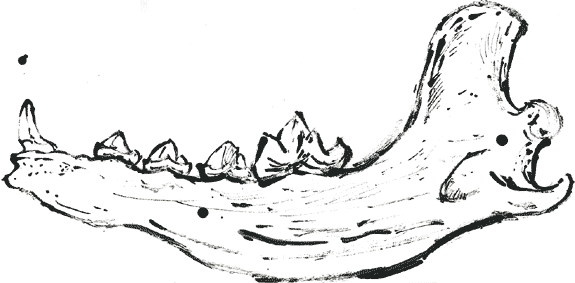
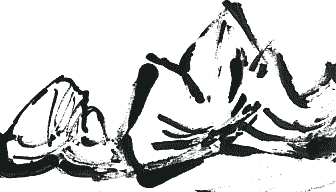 Jawbone
Jawbone
As you can see from the full size detail (left), the bamboo pen gives some unpredictable drama to the line, turning this jawbone into a rugged landscape - making mountains out of molars - but, hang on, it's all very well having an 'interesting' line but isn't the purpose for this class to closely observe natural form, not to impose spurious drama on it?

This text, written with the same pen I used for the drawing, shows how unpredictable the line can be; at least, it's predictable in that every time you dip your pen in the ink, it fills in your first letter with a blot then, a couple of words later, it's starting to dry so you end up with smudgy trails.
I wouldn't put up with such a pen for the simple act of writing, so why am I struggling with it when my main purpose is to observe the complex natural forms that I'm presented with in this class?
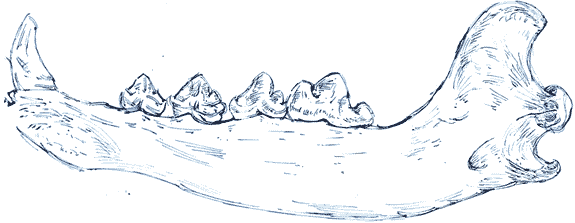
Pen & Pomegranate
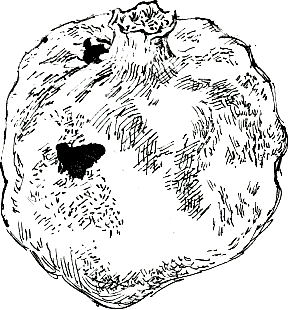 I go for a dip pen and draw the jawbone again (above) but, probably in part because of the rather frustrated mood I'm now in, even that blots when I draw a pomegranate (left).
I go for a dip pen and draw the jawbone again (above) but, probably in part because of the rather frustrated mood I'm now in, even that blots when I draw a pomegranate (left).
You can see how unsettled I've been with the media that I've used during this class but I think the overarching problem that I have with studio-bound natural form drawing as a discipline is that it's so divorced from the 'real' natural world. Every one of these natural form objects - skulls, shells or pinned specimens of exotic butterflies - that are available here in the studio for us to draw could merit a day's careful drawing, if not a week of study. Everything is equally fascinating and beautiful in its own way, so why should one particular object merit more attention than the others? I don't have a particular subject in mind, like geology or marine biology, which I want to follow up for a project. Today I'm drawing for drawing's sake.
To me, the objects are out of context. The crab shell that I drew at the weekend had a story behind it because I'd picked it up on the strandline of a beach I knew well but - for all I know - the starfish I drew alongside it this morning could have been collected on a different continent. For me it has lost its context and some of the layers of meaning around it. It's become little more than an attractive curio.
If I'd spotted the jawbone as the remnant of a fox-kill, I'd have had a purpose in drawing it and a story to tell. Drawing in confines of this studio all day has made me realise that the context of what I'm drawing and the story behind it mean a lot to me. I am, after all, an illustrator not a fine artist.
It's the same with life drawing; I much prefer to draw people behaving normally in their natural habitat - at a street market for example - than I do drawing a model in the rather constrained confines of a life class.
 For my final sketch I go back to my boring old un-experimental Pilot Drawing Pen and draw a skull.
For my final sketch I go back to my boring old un-experimental Pilot Drawing Pen and draw a skull.
Six hours of fairly intensive observational drawing is pretty gruelling and it's a relief to walk out of the college, cross Kensington Gore and the bridge over the Serpentine then head off under mighty trees and across the wide grassy open spaces towards Marble Arch (There I spotted another television presenter, house-hunter and home crafts enthusiast Kirsty Allsopp, who was striding along behind a group of children commenting that she wished she could hire a bicycle. She appeared a good deal less intimidating than John Cleese (see yesterday) - but I still didn't pause to say hello!).
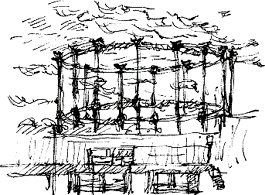 I drew sunset over the gasometer from platform 1 of Kings Cross station as I waited for my train but after all the drawing today I decided to have a change on the way home and I read some of the material I picked up about Sherlock Holmes at 221b and at the Duchess Theatre.
I drew sunset over the gasometer from platform 1 of Kings Cross station as I waited for my train but after all the drawing today I decided to have a change on the way home and I read some of the material I picked up about Sherlock Holmes at 221b and at the Duchess Theatre.
previous | home
page | this
month | e-mail
richard | next
 St. James Park, 8.30 am.
St. James Park, 8.30 am. IT DOESN'T seem likely that a wigeon is higher in the pecking order than a mallard but the drake strutting along the water's edge is apparently out to impress a couple of females who are walking along with him. He's in a mood to pick a fight with everyone he meets, so the larger mallard is wise to give him a wide berth. I've stopped for a few minutes to draw the sleeping and preening snow geese (right), but they move when a gang of larger bar-headed geese swagger along the lakeside path.
IT DOESN'T seem likely that a wigeon is higher in the pecking order than a mallard but the drake strutting along the water's edge is apparently out to impress a couple of females who are walking along with him. He's in a mood to pick a fight with everyone he meets, so the larger mallard is wise to give him a wide berth. I've stopped for a few minutes to draw the sleeping and preening snow geese (right), but they move when a gang of larger bar-headed geese swagger along the lakeside path. On my walk via Trafalgar Square and the Royal Parks, I take a tea-break at the Serpentine Cafe on the terrace overlooking the lake. A heron flies in and sits on the railing by the next table. I'm surprised how small a heron looks when it's sitting so close to you.
On my walk via Trafalgar Square and the Royal Parks, I take a tea-break at the Serpentine Cafe on the terrace overlooking the lake. A heron flies in and sits on the railing by the next table. I'm surprised how small a heron looks when it's sitting so close to you.
 Starfish
Starfish

 Bracket Fungus
Bracket Fungus
 Jawbone
Jawbone

 I go for a dip pen and draw the jawbone again (above) but, probably in part because of the rather frustrated mood I'm now in, even that blots when I draw a pomegranate (left).
I go for a dip pen and draw the jawbone again (above) but, probably in part because of the rather frustrated mood I'm now in, even that blots when I draw a pomegranate (left). For my final sketch I go back to my boring old un-experimental Pilot Drawing Pen and draw a skull.
For my final sketch I go back to my boring old un-experimental Pilot Drawing Pen and draw a skull. I drew sunset over the gasometer from platform 1 of Kings Cross station as I waited for my train but after all the drawing today I decided to have a change on the way home and I read some of the material I picked up about Sherlock Holmes at 221b and at the Duchess Theatre.
I drew sunset over the gasometer from platform 1 of Kings Cross station as I waited for my train but after all the drawing today I decided to have a change on the way home and I read some of the material I picked up about Sherlock Holmes at 221b and at the Duchess Theatre.